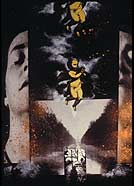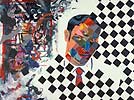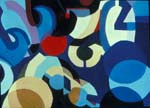Mary Stewart



Description
Experience in conceptualizing, creating, and critiquing two-dimensional compositions using the elements and principles of design. This is a studio course, including hands-on work, critiques, demonstrations, and presentations
Objectives:
Upon successful completion of this course, you will be able to:
- Effectively manipulate the elements and principles of two-dimensional design to create non-objective, abstract, and representational compositions;
- Use a wide variety of idea generation strategies confidently;
- Demonstrate an understanding of correlation between concept and composition;
- Speak and write critically about personal and peer artworks and propose alternatives;
- Research an idea and develop an ambitious Capstone solution.
Assement Criteria
- Skill acquisition and application. Is the composition deliberate, well-crafted, and effective? (40%)
- Idea Development. How effectively have you used thumbnail sketches and other idea generation strategies? How wide a range of possibilities did you explore? (40%)
- Learning Process. Do you come to class prepared? Do you take risks? How substantial and consistent are your contributions to class discussions? (20%)
Assessment
Grades are based on three major factors.
- Is the work conceptually inventive? Did you really grapple with the ideas presented in each assignment?
- Is the composition visually compelling? Is every square inch fully engaged? Have colors been chosen well? Is the image unified? Energized? Well crafted?
- What was the nature of your learning process? Did you use class time effectively and come prepared? Did you take risks? How many solutions did you invent for each problem? How substantial were your contributions to crits?
Attendance
Attendance is required. It is impossible to fully “make up” a missed demonstration or critique. Arriving late also derails learning. Students that miss more than 8 hours of class for any reason generally earn a C or below. More than two unexcused absences will result in a C or below. More than 3 unexcused absences will result in a D or below.
Note: One project will be accepted one day late without penalty. One additional late project will be accepted with a one letter-grade penalty for each day it is late.
Basic Supplies
Always bring 9x12" sketchbook, pencil, ruler, exacto knife, scotch tape, and scissors
4 non-toxic markers: black, gray, blue
Mars white eraser and Uhu glue stick
fine point felt pen, black
exacto knife and 25 extra blades (#11 size)
1 22x30" sheet Black Arches paper
4 Prismacolor pencils: 2 metallic, 2 non-metallic
2 19x25" sheets black construction paper
24" cork backed stainless steel ruler
1/2x60" artists’ tape
12x18" or larger self-healing cutting surface
Additional supplies will be needed for your Capstone project, for which you choose the medium.
Required Textbook
Launching the Imagination: A Comprehensive Guide to Basic Design.
Section 1: Basic Elements
Week 1: Line
Assignments: Line Inventory; 4 Lines/4 Times; Line Dynamics.
Written assignment: Biographical Statement.
Reading: LTI, Introduction; C 1
Week 2 & 3: Shape
Assignments: Shape Inventory; Black and White
Reading: LTI, C 4
Weeks 3, 4, & 5:Texture
Assignment: Texture Inventory; Visual Alchemy
Reading, LTI, C 5, 6
REVIEW #1 INDIVIDUAL APPOINTMENTS
Section 2: Basic Principles
Week 6: Abstraction and Organization
Assignment: Architectural Abstraction: balance, emphasis, scale, proportion, and density
Written assignment: Turn Up the Heat critique.
Reading: LTI, C 3
Week 7, 8: Simplicity and Complexity
Assignments: Labyrinth Collage #1 and #2, exploring movement and illusion of space
Written assignment: Alternatives Critique
Reading: LTI, C 11
Weeks 9, 10,11: Multiplicity
Assignment: Labyrinth book: Continuity, contrast, framing
Reading: LTI, C 12, 13
Written Assignment: Visual Vocabulary test
REVIEW #2 INDIVIDUAL APPOINTMENTS
Section 3: Concepts and Communication
Reading: LTI, C 7
Weeks 12-15: Capstone Project
Reading: LTI, C 7, Written and drawn assignment: Visual Vocabulary
The Bottom Line
Classes within the Art Department are unique within the University system in that you are actively encouraged to discuss and critique the work of your peers and to cite areas where it excels, and where it needs improvement. To achieve this, we all work together to build an environment of trust, honesty, and strong listening skills. This course has a heavy workload. If your schedule is heavy, drop the course now. This class will require at least 7 hours of work outside of class per week.
Mary Stewart email address: marystewart3@gmail.com

